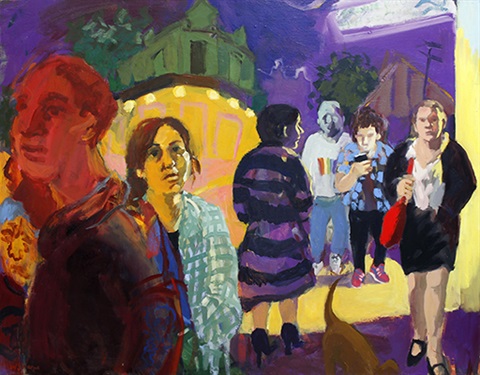CAL2019.1 Wendy Sharpe

Title
Erskineville Train Station
Location
In storage
Place of origin
Sydney NSW, Australia
Year
2019
Media
Painting
Medium
oil on canvas
Dimensions
145 x 182 cm
Credit
Winner Calleen Art Award 2019
Accession number
CAL2019.1
On Wendy Sharpe, by Peter Haynes (2020)
Wendy Sharpe is one of Australia’s foremost visual artists, with a distinguished national and international profile. Born in Sydney in 1960 the artist studied visual arts and education at the (then) Seaforth Technical College (1978-79); the (then) City Art Institute, Sydney (1980-82, and 1984); the Sydney Institute of Education (1983); and the UNSW College of Fine Arts (1991-92). She has exhibited regularly and substantially in group and solo shows in Australia and overseas since 1985. Sharpe has been involved in numerous residencies including most recently the Hamlin Fistula Foundation in Ethiopia (2019); the State Library of NSW (2017-18); Circus Oz (2015-16); Zhouzhuang, China (2015); the Obracadobra Residency in Oaxaca, Mexico (2014); and in Antarctica (2012) as part of the Mawson Centenary celebrations.
Among her many awards and prizes are the Adelaide Perry Drawing Prize (2014); the Portia Geach Memorial Prize (1995, 2003); the Bathurst Art Prize (1998); the Waverley Art Prize (1990-95); and the prestigious Sulman (1986) and Archibald (1986) Prizes, both at the Art Gallery of New South Wales. In 1999 Sharpe was appointed by the Australian War Memorial as Australian Official Artist attached to the Australian Army History Unit in Dili, East Timor, the results of which were shown at the Australian War Memorial in Canberra (2000). Her work is held in numerous major collections including the Art Gallery of NSW; the National Portrait Gallery, Canberra; the State Library of NSW; the Australian Embassy Paris; and many regional, institutional, corporate and private collections throughout Australia.
Erskenville Train Station, the winning painting in the 2019 Calleen Art Award, continues the artist’s predilection with figuration. The figure has played a paramount role in her art since the 1980s and provides ongoing and fertile inspiration for her practice. Erskenville, the eponymous suburb of the title, is where the artist lives in Sydney. She makes the trip to her studio in nearby St Peters through the busy streets, and these and their denizens become the setting and the subjects that populate this work. The artist also includes herself in the composition, a signature mannerism that began in the late 1990s and continues to the present day. Her presence places her as both participant and observer, roles that mirror those of her viewers who are invited not only to enjoy the vigour and energy of her painting, but also to contemplate what might be happening in her painterly mise-en-scène.
Sharpe’s painting has a theatrical, almost stage-like quality underscored by her dramatic use of lighting and the frontal positioning of (most of) the figures in the pictorial space. The interplay of figures with light and shade is very effective in establishing a narrative ambiance that is integral to her expressive armory. The spirited gestural brushwork, allied with the artist’s astute use and understanding of contrasting colours, allow her ambient urban environment and its unfolding (yet unstated) narrative to come to the fore in this embracingly seductive work.